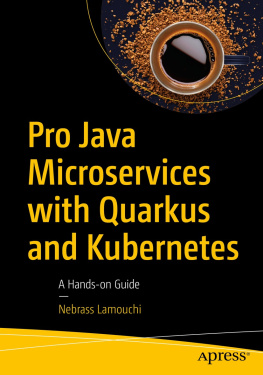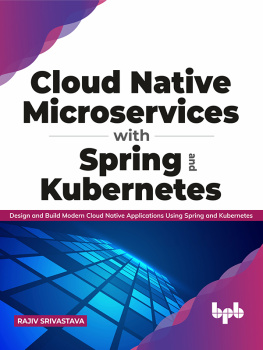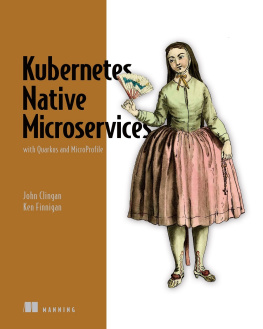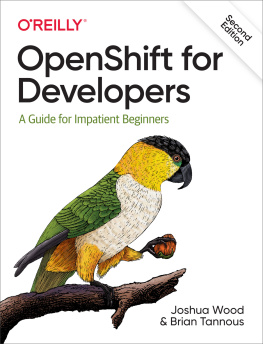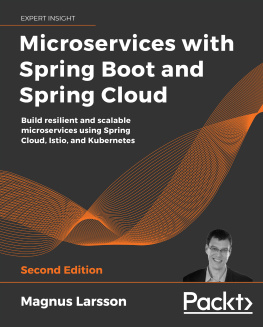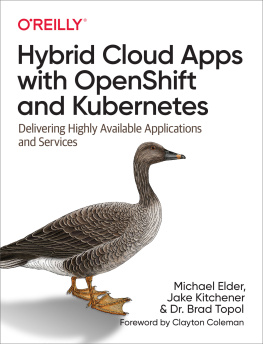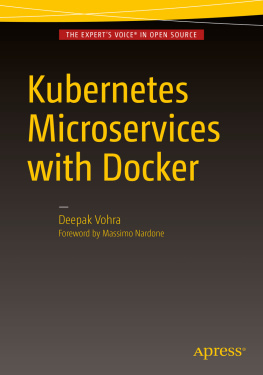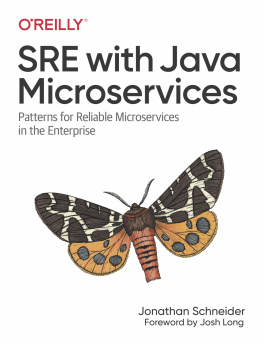Nebrass Lamouchi - Playing with Java Microservices on Kubernetes and OpenShift
Here you can read online Nebrass Lamouchi - Playing with Java Microservices on Kubernetes and OpenShift full text of the book (entire story) in english for free. Download pdf and epub, get meaning, cover and reviews about this ebook. year: 2018, publisher: leanpub.com, genre: Computer. Description of the work, (preface) as well as reviews are available. Best literature library LitArk.com created for fans of good reading and offers a wide selection of genres:
Romance novel
Science fiction
Adventure
Detective
Science
History
Home and family
Prose
Art
Politics
Computer
Non-fiction
Religion
Business
Children
Humor
Choose a favorite category and find really read worthwhile books. Enjoy immersion in the world of imagination, feel the emotions of the characters or learn something new for yourself, make an fascinating discovery.
- Book:Playing with Java Microservices on Kubernetes and OpenShift
- Author:
- Publisher:leanpub.com
- Genre:
- Year:2018
- Rating:4 / 5
- Favourites:Add to favourites
- Your mark:
- 80
- 1
- 2
- 3
- 4
- 5
Playing with Java Microservices on Kubernetes and OpenShift: summary, description and annotation
We offer to read an annotation, description, summary or preface (depends on what the author of the book "Playing with Java Microservices on Kubernetes and OpenShift" wrote himself). If you haven't found the necessary information about the book — write in the comments, we will try to find it.
Playing with Java Microservices on Kubernetes and OpenShift — read online for free the complete book (whole text) full work
Below is the text of the book, divided by pages. System saving the place of the last page read, allows you to conveniently read the book "Playing with Java Microservices on Kubernetes and OpenShift" online for free, without having to search again every time where you left off. Put a bookmark, and you can go to the page where you finished reading at any time.
Font size:
Interval:
Bookmark:

This book is for sale at http://leanpub.com/playing-with-java-microservices-on-k8s-and-ocp
This version was published on 2020-01-14

* * * * *
This is a Leanpub book. Leanpub empowers authors and publishers with the Lean Publishing process. Lean Publishing is the act of publishing an in-progress ebook using lightweight tools and many iterations to get reader feedback, pivot until you have the right book and build traction once you do.
* * * * *
ISBN for EPUB version: 978-2-9564285-1-0
ISBN for MOBI version: 978-2-9564285-2-7
To Mom, its impossible to thank you adequately for everything youve done.
To the soul of Dad, I miss you every day
To Firass, you are the best, may God bless you
To my sweetheart, since youve come into my life, there are so many new emotions and feelings
begging to come out..
I would like to express my gratitude to the many people who saw me through this book.
To all those who provided support, read, wrote, offered comments and assisted in the editing and design.
To my wife and my family thank you for all your great support and encouragements.
To my friends thank you for always being there when I need you.
To Jrome Salles, thank you for teaching me the Java EE Art and for your support and guidance.
Last and not least, I beg forgiveness of all those who have been with me over the course of the years and whose names I have failed to mention.
Playing with Java Microservices on Kubernetes and OpenShift will teach you how to build and design microservices using Java and the Spring platform.
This book covers topics related to creating Java microservices and deploy them to Kubernetes and OpenShift.
Traditionally, Java developers have been used to developing large, complex monolithic applications. The experience of developing and deploying monoliths has been always slow and painful. This book will help Java developers to quickly get started with the features and the concerns of the microservices architecture. It will introduce Docker, Kubernetes and OpenShift to help them deploying their microservices.
The book is written for Java developers who wants to build microservices using the Spring Boot/Cloud stack and who wants to deploy them to Kubernetes and OpenShift.
You will be guided on how to install the appropriate tools to work properly. For those who are new to Enterprise Development using Spring Boot, you will be introduced to its core principles and main features thru a deep step-by-step tutorial on many components. For experts, this book offers some recipes that illustrate how to split monoliths and implement microservices and deploy them as containers to Kubernetes and OpenShift.
The following are some of the key challenges that we will address in this book:
- Introducing Spring Boot/Cloud for beginners
- Splitting a monolith using the Domain Driven Design approach
- Implementing the cloud & microservices patterns
- Rethinking the deployment process
- Introducing containerization, Docker, Kubernetes and OpenShift
By the end of reading this book, you will have practical hands-on experience of building microservices using Spring Boot/Cloud and you will master deploying them as containers to Kubernetes and OpenShift.
Chapter 1, Introduction to the Monolithic architecture, provides an introduction to the Monolithic architecture with a focus on its advantages and drawbacks.
Chapter 2, Coding the Monolithic application, offers a step-by-step tutorial for modeling and creating the monolith using Maven, Java 8 & Spring Boot 2.x.
Chapter 3, Upgrading the Monolithic application, lists some upgrades for our Monolithic application such as changing the DBMS..
Chapter 4, Building & Deploying the Monolithic application, covers how to build and package our example application before showing how to deploy it in the runtime environment.
Chapter 5, Microservices Architecture Pattern, presents the drawbacks of the Monolith architecture pattern and shows the motivations for seeking something new, like the Microservices architecture pattern.
Chapter 6, Splitting the Monolith: Bombarding the domain, presents the Domain Driven Design concepts to successfully understand the Business Domain of the Monolithic Application, to be able to split it into sub-domains.
Chapter 7, Applying DDD to the code, shows how to apply all the DDD concepts to the Monolithic Application source code and to successfully split the monolith into Bounded Contexts.
Chapter 8: Meeting the microservices concerns and patterns, covers a deep presentation of the concerns and the cloud patterns related to the Microservices Architecture Pattern.
Chapter 9: Implementing the patterns, shows how to implement the presented cloud patterns using Java & Spring Boot/Cloud stack.
Chapter 10: Building the standalone microservices, covers how to build our real standlone business microservices.
Chapter 11. Getting started with Docker, presents the containerization and Docker technology.
Chapter 12. Getting started with Kubernetes, presents in deep the greatest container orchestrator: Kubernetes
Chapter 13: The Kubernetes style, shows how to apply the Kubberentes concepts and features to our microservices.
Chapter 14: Getting started with Openshift, presents OpenShift Container Platform, a Kubernetes based PaaS.
As this book is published online, I will be providing regular updates for chapters, adding new ones, covering more items, etc..
If you want that I write about any item of the Java/Kubernetes ecosystem, feel free to get in touch with me directly on .
The source code of this book is available on my Github:
- https://github.com/nebrass/playing-with-java-microservices-monolith-example
- https://github.com/nebrass/playing-with-java-microservices-book-code
Lets imagine that we are developing an e-commerce backend application using Java & Spring Boot. Our e-commerce will have different clients including desktop browsers, mobile browsers and native mobile applications. The application can expose many APIs to be used by 3rd parties. The application handles many requests by executing business logic; accessing a database; exchanging messages with a broker and returning HTTP responses.
The e-commerce has many modules managing customers, orders, products, reviews, carts, authentication, etc..
Many team of developers are working on our application. Every team is working on a module.
Our application is a Java EE application. It is deployed as a huge WAR file that is wrapping all e-commerce modules. To deliver our application, the project manager has to be sure that all teams have delivered all the code of each module; if one of the teams had some delays for any reason, all the application will be delayed for sure, as it cannot be delivered with unfinished parts.
> How can we solve this ?
Our technical stack is somehow sexy :D almost all Java Developers love working with Java 8 and Spring Boot. So when recruiting a new developer, we expect that our new developer will be happy to start working on the e-commerce. But does this will be true ? Our developer will be happy to meet all the code of the e-commerce when he is coming to work on the products module only ? Does this additional complexity is mandatory ?
Font size:
Interval:
Bookmark:
Similar books «Playing with Java Microservices on Kubernetes and OpenShift»
Look at similar books to Playing with Java Microservices on Kubernetes and OpenShift. We have selected literature similar in name and meaning in the hope of providing readers with more options to find new, interesting, not yet read works.
Discussion, reviews of the book Playing with Java Microservices on Kubernetes and OpenShift and just readers' own opinions. Leave your comments, write what you think about the work, its meaning or the main characters. Specify what exactly you liked and what you didn't like, and why you think so.


